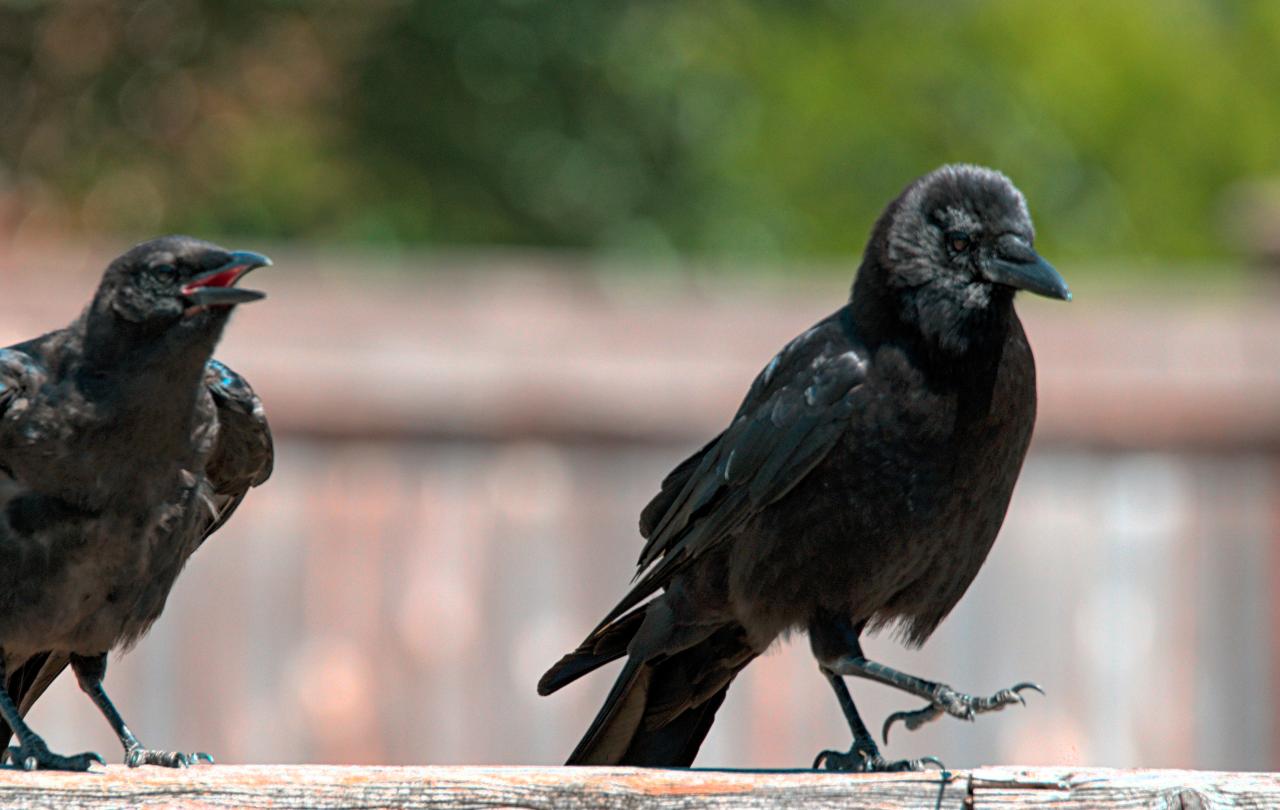
Our neighbours hate our crows. I can’t blame them. The hundreds of crows that occupy the tops of the ancient pines which surround our rural manse are the noisiest and messiest residents I have ever lived near. They greet each sunrise with a din of caws and counter-caws, as if they are deeply concerned that anyone might miss this momentous daily event or the fact that it’s now happening before 5:30a.m. In nesting season, which lasts most of April and May, our car is easily identifiable in any carpark by the crusted grey spots with which the crows see fit to adorn it. Within a week of moving in, we gave up on the washing line so invitingly strung between two of the pines. Our pristine whites were too tempting a target for our crows.
I do not attend the meetings of our local community council, but I hear whispers of what transpires there. Our crows, evidently, have been a regular topic of conversation. Multiple solutions have been proffered for driving them away. All have been tried and all have failed. Our crows cling fiercely to their homes and their determination is more than a match for any human efforts. If I have the vibe of my community right, at least some of its members feel that there’s something perverse, obscene even, about a flock of birds being allowed to upset our human right to create a serene, comfortable, and convenient habitation. Our clump of houses is surrounded by a visually stunning landscape; shouldn’t the aural landscape be equally beautiful?
If my family does not mind our crows, it is because the treetop drama is just one more example of many natural encroachments on the house, some more welcome than others.
Every year we celebrate the miraculous return to our eaves of house martins, home from their intercontinental peregrinations. We look forward to another summer spent watching their acrobatics and listening to their chicks in the nests an arm’s length from our windows.
Clearing up the mess of our attic’s bats is an annual chore, one thankfully performed stoically by our church’s property convener, but there are compensations - such as the twilight shows they put on outside our living room window, performing impossible turns and reversals midair in their search for prey.
Less welcome are the massive spiders, which are a perennial presence; the slugs, which seemed to apparate onto the hall carpet all through winter, the mice, two of whom sacrificed themselves to knock our dishwasher out of action by chewing through its hose; and the wasps who built a nest the size of a telephone box in the roof space above our back bathroom.
Least fun of all has been what we call the Great Earwig Migrations, which have happened twice in our half-decade in the manse and which involve weeks of finding the little bugs under, seemingly, every object and on every surface.
When we moved into the manse, we expected challenges, the high heating bills, the leaking roof, and the isolation of the countryside. What we did not expect was the experience of porousness; the shock of realising that we had so little control over what other forms of life saw fit to share our habitation with us.
At first it felt to me perverse, obscene even, that a house, even a 120-year-old house, should be so vulnerable to incursions by animal creation. Shouldn’t our home, our space, be a haven where we can control who or what enters, who or what we feel comfortable with, and who or what we can exclude?
If I had to give a name to this expectation, maybe it would be that of the buffered home, a play on philosopher Charles Taylor’s description of the modern self as buffered. Taylor contrasts the selves we aspire to be in modernity, ones able to control and order our bodies, our space, our lives, and our relationships so that they accord with our autonomous desires and actions, with those of our premodern ancestors. Medievals and ancients assumed porosity. Bodies were subject not just to biological infection, but spiritual infections too. Projects and plans were frustrated not just by mistakes or personal failings, but by the ever-fickle whims of the goddess Fortuna. Their lives, their bodies, their homes, existed in a perpetual state of vulnerability. The threat of everything falling apart was always on the horizon.
We want nature to survive, flourish even, but not at the cost of our comforts or our sense of autonomy and security.
Modern technology has helped us tame the more unwelcome of these forces, but it has also given us an overly naive expectation that all that is inconvenient about nature can and should be gradually eliminated. This expectation frames the way we respond to worries about climate change and other creeping environmental crises. We want nature to survive, flourish even, but not at the cost of our comforts or our sense of autonomy and security. But as our ancestors might remind us, we are part of nature too, and, just as in any relationship, mutual vulnerability and sacrifice are needed if we are all going to survive. This is scary, but there are resources within Christianity - within other faiths too - to help us understand that there are benefits to affirming our vulnerability, our porosity.
My daughters love our crows. They point in wonder as the crows flood into the sky at dusk, hundreds of them making a giant circle once, then twice round the garden, before settling down for the night. When, in late May, grounded fledgings appear, bundles of feathers shocked at the sudden inhospitality of the nest, too stunned to realise they can fly home, my daughters watch over them, anxious lest the local cats take advantage of their bewilderment.
A few Sundays ago, my youngest, who struggles to stay quiet and well-behaved in Sunday School, pulled me out of church early. We sat on the church lawn staring up at the crows and soon were adapting the andante melodies of that Sunday’s hymns into imagined songs of praise that crows might sing. “No,” my youngest said, simpatico with the crows as she is, “I think they’d want something more upbeat.” And so we tried setting our own corvid-themed praise lyrics to Rosé and Bruno Mars’ song APT, while listening to the caw and counter-caw above. “Dad, how do you think God sees the world?” she asked me when we finished. I stumbled through my best theologically informed explanation of how God could be in every part of creation without being of it, before she stopped me. “I think it’s like a giant snow globe that he holds in his hands.” Watching the birds swirl around us, two stationary figures caught by the same currents of air that were sweeping them aloft, what could I do but agree?
Support Seen & Unseen
Since Spring 2023, our readers have enjoyed over 1,000 articles. All for free.
This is made possible through the generosity of our amazing community of supporters.
If you enjoy Seen & Unseen, would you consider making a gift towards our work?
Do so by joining Behind The Seen. Alongside other benefits, you’ll receive an extra fortnightly email from me sharing my reading and reflections on the ideas that are shaping our times.
Graham Tomlin
Editor-in-Chief





